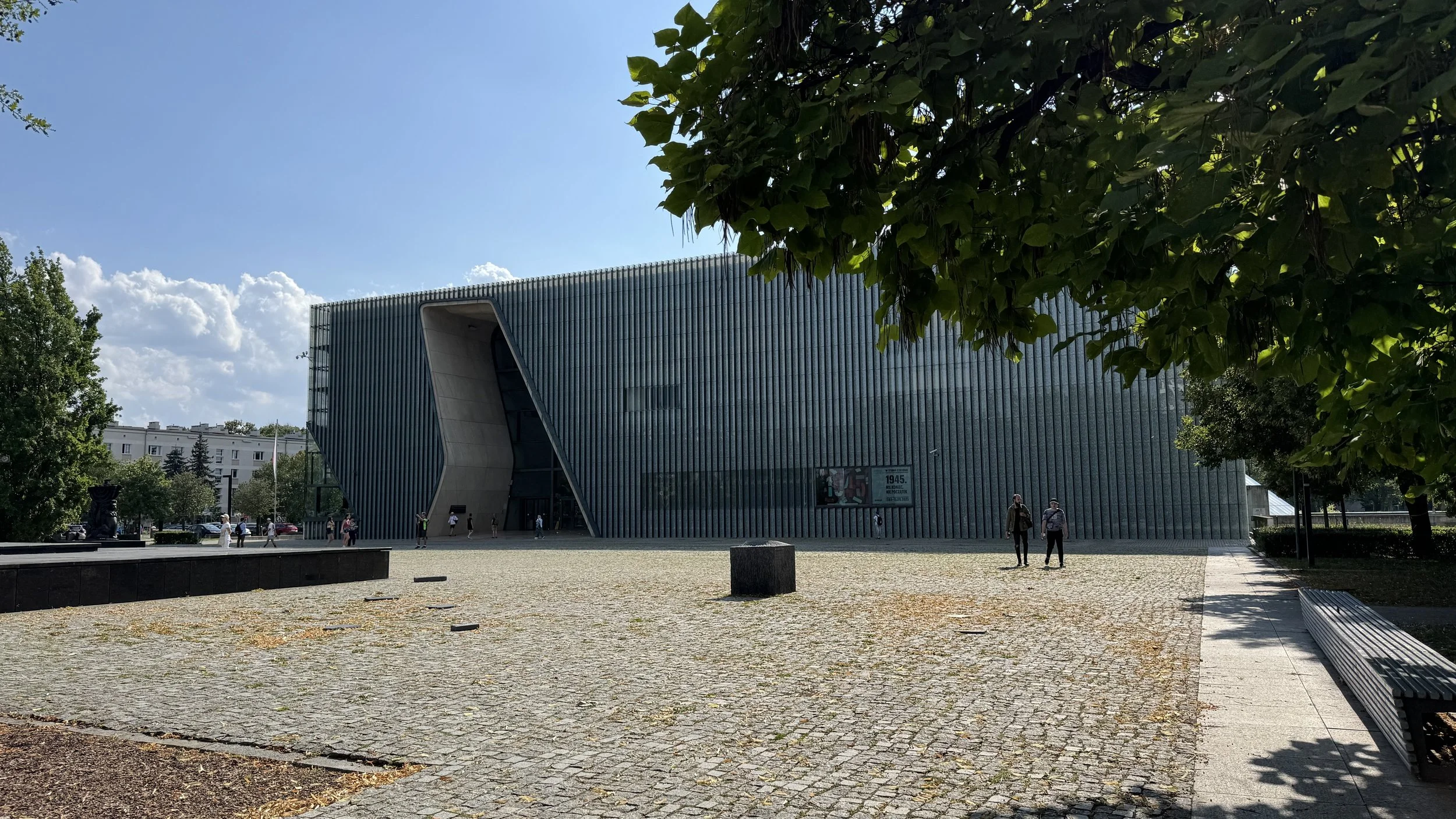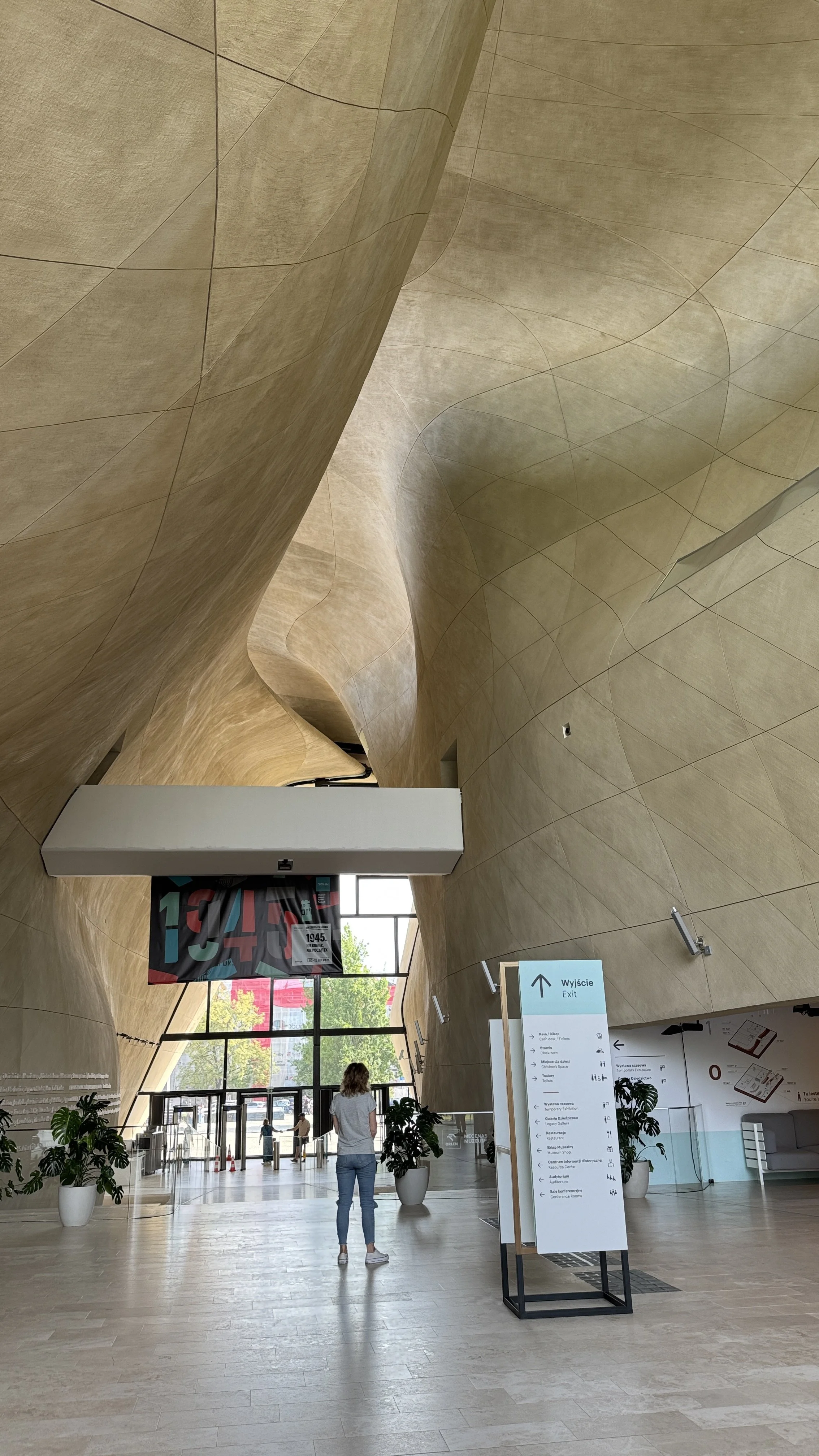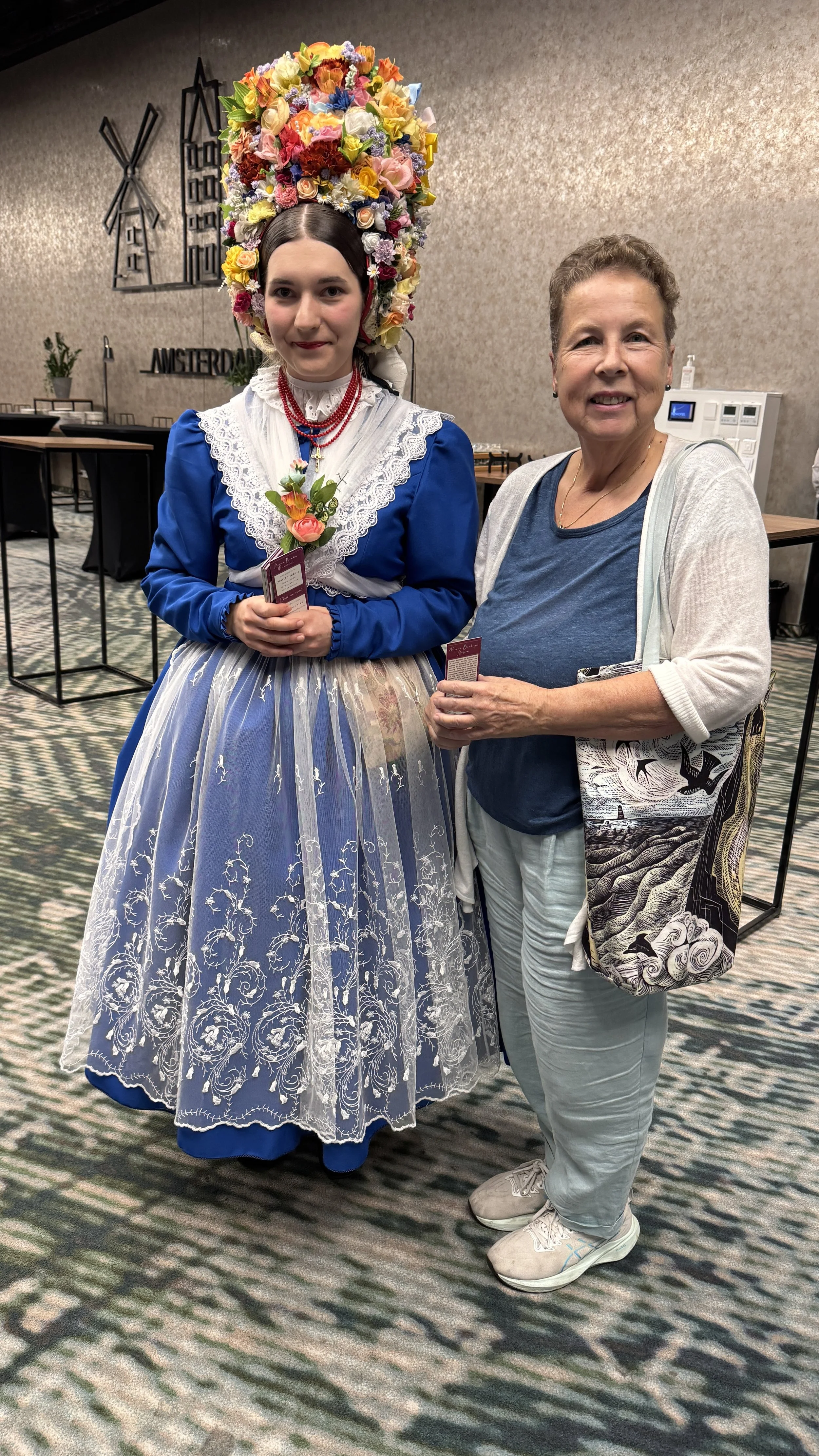Poland
Part One
Between visiting our daughter in England and our American friends joining us soon in Europe, we sought something to occupy our time in August, a month when every European country vacations during school holidays. It’s hot everywhere and tourists from all over the world descend upon this continent. When we discovered that the annual Urban Sketcher Symposium would occur in Poland during August, we were thrilled: this is ideal! Let’s explore Poland and attend the Symposium.
Poland isn’t yet a popular destination, we thought. What an oversight! We have joined the world in discovering how very delightful Poland and the Polish people are.
Old city of Gdansk from across the harbor
We landed in Gdansk, a lively city on the Baltic Sea. On the second day, we had our carefully crafted plans driving through Poland upended. I needed an International Driver’s Permit (IDP) from AAA along with my MA driver’s license from the USA. No IDP, no rental.
St. George slaying the dragon with
Marienkirche, iconic in Gdansk, one of the world’s largest Gothic-style brick churches
Fortunately, AAA recently implemented an on-line application. We ordered an IDP to be delivered to our hotel in Poznan where the Symposium will take place. It hurt a bit to cut out the areas of Masuria and Białowieża National Park (NP) in the east, close to the Belarus border, and both of particular interest to me.
They are supposedly beautiful nature areas: Masuria so detailed in German author Günter Grass’s (“the Tin Drum”) books from his youth with lots of lakes and whatnot, and the NP famous for the free roaming European Bison, a species once on the brink of extinction but recently recovered. Instead, we added several days to Gdansk and Warsaw and booked trains until Poznan.
Gdansk, Danzig in German, turned out to be an excellent beginning. Poland was a blank slate: we knew very little of what to expect.
Immediately, we were taken in by the friendliness of the Polish people, always and everywhere. We tried to return the favor by learning some Polish words, the regulars: thank you, good bye, you’re welcome, and excuse me. The eyes of those we spoke to always lit up when we responded in their language: Polish is so difficult that most people don’t even bother trying.
All brand-new buildings, including the most expensive apartment in Gdansk, right at the waterfront; erected where old, dilapidated warehouses once stood
The difficulty might have to do with how the language is written, not as pronounced, but completely different. Examples:
Dziękuję = thank you [tschinn-kooye]
Przepraszam = excuse me; I’m sorry [sheprasham]
Mężczyzna = man, male [mestsheezna]
I liked the many tsh and dsh dipthongs, which sound really nice to my ears.
Gdansk after WW2 - courtesy pic of a museum
We hoped that we would not like the food as we wanted to eat less; that didn’t work out. The food is absolutely delicious and they often serve huuuge portions. Very little food products are imported, most meat and produce is raised in country, and so everything tastes fresh. Being here in August means that blueberries, red and black currants, Chanterelles and other mushrooms are in season and the Polish take their mushrooms seriously. Mushroom foraging in the forests is a national pastime that nearly everyone partakes in. And their little potato dumplings are even more scrumptious than Italian Gnocchi.
Pierogi, mushrooms with little potato dumplings, red currants, pickled red beet
Vodka with currant juice and Tabasco (called “Mad Dog”)
Gdansk is a town close to the Baltic Sea and was occupied by Nazi Germans during WWII. During the final weeks of the war, Nazis remained in Gdansk to block the Soviets from quickly reaching Berlin. When the Soviet Army arrived to liberate Poland, they destroyed 90% of the Old Town with only a few days left before the war’s end.
“When the reconstruction of the old town and center began, only the layout of the buildings on plots marked out in the Middle Ages remained unchanged. The restorers therefore had to decide which of the historical versions would serve as the starting point for the reconstruction. It was decided to restore the appearance of the city from its heyday, so facades were reconstructed in styles ranging from Gothic, through Renaissance, Mannerism, Baroque, to Rococo and Classicist. Later solutions were not used for two reasons. It was believed that the styles of the 19th century were imitative and devoid of artistic value, and due to the short distance of time they were not subject to protection. In addition, it was the time when Gdansk belonged to the Kingdom of Prussia and the German Empire, which evoke bad associations.” (Bohdan Szermer, architect; from an exhibit about reconstruction in the Fore-gate Complex[Prison Tower])
Poland is a global leader in Baltic amber, and many people hunt the fossilized resin from ancient trees along the coast at night using black light flashlights which make the resin glow in the dark
So, today, Gdansk’s center is a hodgepodge of buildings with facades of different periods on the outside, with rather modern interiors. Colorful and visually appealing, Gdansk has this story to tell and it attracts many tourists during the summers. During our stay, Gdansk celebrated St. Dominic’s Fair for the 765th year, a fair lasting 3 months with rows of over 180 booths spread throughout the old town area selling stuff, for the first time not full of cheap Chinese plastic wares, but proudly presenting Polish hand-made or Polish manufactured crafts, souvenirs, and other items.
Still, many areas of the city center await new buildings, and we got the impression that there is a lot of entrepreneurial spirit, especially in real estate, as the prices are still low compared to other European countries. Yet, the quality of living appeared to be more advanced, especially anything technological, more than even in the USA. Together, with the friendly mentality of the people and the feeling of safety (all over Poland), we were very positive surprised.
I think these are Barley fields later used to distill Vodka
The train ride from Gdansk to Warsaw (Poland’s new capital since 1596) was very comfortable, on time and took only two and a half hours. Poland is mainly flat. Outside of the big cities, we spotted lots of grain fields, either nicely yellow, which is probably wheat, but even more greyish-beige, which is probably rye. Rye is used everywhere in the Polish cuisine and is part of their huge array of exquisite tasting bread variations. Some of the grain fields were most likely also Barley, which we learned is the main ingredient of Vodka. And there were some really interesting flavors of vodka for us to explore. In the grain fields, we saw hundreds of modern wind turbines for kilometers on end, in groups of 2-15, interspersed with fields of solar energy panels on the ground. When there were no grain fields, we traveled through beautiful green pastures and mixed forests.
Asparagus soup with smoked goat cheese balls
In Warsaw, we stayed in a very nice area, away from the crowds, comparable to Schwabing in Munich or South End in Boston. We rented a studio apartment and had small restaurants, cafes and shops all around us, sitting outside, sipping cappuccino in the warm, but comfortable, weather, just like summer in the city should be.
We booked a food tour, which is an excellent way to absorb more about the culture and history of the place. We learned that Poland cooks more than 400 distinctive Polish soups. We felt that in the restaurants, the food is made from scratch, no shortcuts. When I once commented to the waiter of a fantastic and very unusual tasting clear broth (with goose hearts), he told us that they start their soups always the day before, so that they are simmering for over 10 hours. Borscht, here, is a clarified, clear beet soup, traditionally only served within the families on Christmas. Our favorite soup is Zurek, the Easter soup, a bit sour as it is started and fermented with rye and water before adding other ingredients like potato, slices of different sausages, and half of a boiled egg.
Variations on potato dumplings
Quark and potatoes, one of Randy’s favorites while living in Europe ages ago
Mushrooms are a main staple in Polish food as meat was difficult to acquire for a long time. The most Polish dish is considered nowadays to be breaded pork schnitzel with honeyed sauerkraut, but we tried so many other Polish/Slavik dishes as well: stuffed cabbage, filled beef rolls, rabbit, duck in all variations.
In Warsaw, donuts without a hole, filled with rose-hip jelly and other jams called dobra paczkarnia is a sweet specialty they’re very proud of.
Poland has also started producing their own wines since about 15 years thanks to ever warming global temperatures, which are very pleasant and drinkable, especially their white wines. There are many different manufacturers of tasty Polish beer as well. Since every family can distill their own vodka from barley, so many restaurants sell their own “craft” vodka, from black currant to herbal and many, many more flavors.
"Okno życia" translates to "window of life" and refers to a baby hatch, a safe, anonymous place where people can leave newborns to be cared for by others
When we discovered a baby drop off hatch in the wall, we were told that Poland does not allow abortions, so every child has to be carried to term, no matter the medical issues or genetic disorders.
Once the child is born, the government does not help much with care for difficult babies. That explains the “Window of Life” that we saw walking down a street, in a house run by the non-profit organization Caritas. Babies who are left there are adopted quickly to new and wealthier parents.
Warsaw was very heavily destroyed during the second World War, and has also a mix of different styles of residential houses in the center, but not as colorful and cookie-cutter as in Gdansk. As the Soviets occupied Poland for a while, a lot of harsh soviet-style administrative buildings are mixed in everywhere.
After the Soviets left and Poland became a democracy, they had to deal with the highest building in Warsaw, which was clearly Soviet style. The solution was to build several other skyscrapers in a circle around the iconic building so it wouldn’t be too prominent.
As we knew that there is not much to see in Warsaw, we didn’t bother to travel much around. We did laundry in the apartment, I got a haircut, we mailed postcards, walked around the area, sat on our miniature balcony for breakfast and coffee – just enjoyed a very nice city life. No rush anywhere, just sleeping in and binging Netflix. Just like at home, but in Warsaw.
We made two excursions, one to explore the UNESCO Stare Miasto (old town).
Loved the little details in Śródmieście, Warsaw’s Old Town district
Warsaw - Royal Castle Square
Warsaw - old market square
Coat of Arms of Warsaw
The only place that really pulled us was the POLIN Museum: the museum of the history of Polish Jews. There we have gaps in our knowledge, because especially for me, everything historically has always to do with Germans.
POLIN Museum - Museum of the History of Polish Jews; located on the site of the former Warsaw Ghetto
The Polish viewpoint, therefore, was very interesting. We learned about the arrival of Jews in Poland around the 10th century after fleeing persecution in Western Europe. We followed a Jewish trader buying and selling his wares along the Amber Road, connecting Central and Eastern Europe with the Baltic Sea. Jews were in good favor of the royalty because of their honesty and learned skills. They were even allowed to own Christian slaves.
They were the money lenders because of Christian usury laws prohibiting Catholics from the profession. However, as Christianity gained a larger foothold, the Church first petitioned against the practice of Jews owning Christian slaves and then pushed hard for the ownership of Jewish slaves as they were not worthy of freedom having not accepted Jesus as their savior. This was this start of antisemitism in Poland.
POLIN Museum on the inside - Lobby
We learned more about antisemitism in the 11th and 12th centuries, spurred on by the emerging Catholic church, and the difficult living conditions for Jews through the centuries (living outside the city walls, prohibited to take certain professions, prohibited to own land, and much more), always being the scapegoat. There were, of course, also success stories, how they felt safe at times in such a prosperous country, Poland being on the intersection of so many trade routes through the 14th - 18th centuries.
For a hundred years between the 16th and 17th centuries, religious tolerance helped create a Golden Age for Jews, but this ended in a pogrom during the Cossack-Polish War after which the Russian invaders devastated Jewish communities.
For the next few hundred years, Poland didn’t exist as an independent country as it was parceled between Austria, Prussia, and Russia and the leaders of those countries scorned Jewish people.
Poland regained its independence after the WWI in 1918 and there was a second renaissance for Jewish Poles, but that ended with the invasion by Nazi Germany and the Soviet Union in 1939 at the outset of the Second World War.
In the mid 20th century, the Nazi invaders decided to build most of their concentration camps in Poland, out of the view of the world. The POLIN Museum today is built exactly where, in the 1940s, the Warsaw Ghetto, cramped with 400,000 Jews on a tiny plot of land, was situated. Ninety percent of all Polish Jews perished during the Nazi German occupation.
After the end of the war, Poland was under communist rule and everyone struggled to survive, so antisemitism inconceivably continued. Seventy percent of the remaining Jews emigrated to other countries throughout the world due to continued violence, political instability, and the destruction of Jewish life and institutions in Poland. Overall, the museum was informative and very moving.
Gitty with a Bamberga - a Polish lady with a heritage of the Bavarian Bamberg area
So much for our first two weeks in Poland. In our next post, we will report about the Urban Sketchers Symposium that brought us here and I will write about the rest of this friendly and honest, modern and cultural-rich country.



